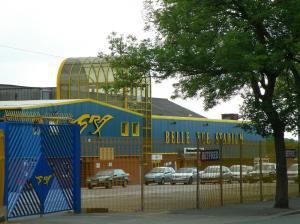“Some are born great, some achieve greatness, and some have greatness thrust upon them” so said William Shakespeare. The final line to bring that up to date is “and then there are those who achieve greatness buy spun king loads of cash on a project”
Let me take you back to 1931. The Empire State Building has just been completed in New York City, A banking crisis threatens the European economy and the first screenings of Dracula and Frankenstein scare the living daylights out of film goers in London. But in a closed meeting room at the Football League headquarters in Preston there was a monumental debate raging.
At the time there was no automatic promotion between the Football League and the Non Leagues. In fact the 92 team Football League was basically a closed shop, with no team ever “elected” to join the league at the annual end of season vote. The process used to be that any non league club could throw their hat into the ring to be elected as a new member club but it would require a majority vote from the Football League club chairman. And unsurprisingly they were a close knit group who didn’t like outsiders. In fact it wasn’t until 1951 that Workington became the first club to join the Football League in this way at the expense of New Brighton. Occasionally an incidence would occur when they found themselves a team short and they would send a telegram to a non league club and ask if they wanted to join the party.
You didn’t have to even prove you were a successful club to apply for election. Take the case of The Argonauts in 1928 who applied for entry to the league without ever actually playing a game. The one thing they had going for them apart from having an eccentric chairman was that they had agreed a lease to play at Wembley Stadium. The excellent Twohundredpercent website tells the story of the most bizarre club nearly to play in the league brilliantly.

For the next two seasons they continued to tread water in the county leagues, applying for election and failing. Then something quite amazing happened. The 1931/32 season was two months old when Wigan Borough were forced to resign from the Third Division North after they ran out of money. So faced with playing the league with one club short the Football League convened an emergency meeting and looked at who could immediately step up into the league. Up stepped Ayrton with a 34,000 stadium in one hand and a master plan in the other. Manchester Central were to be the next footballing force in the North West. The Football League committee were suitably impressed and offered them the vacant spot with immediate effect.
However, before a ball could be kicked both Manchester City and United raised an objection. This town ain’t big enough for the three of us, they cried. Despite United playing in the west of the city at Old Trafford, and City at Maine Road, they were worried of the influence Central could have on their very livelihoods. Amazing to think that at that time United were a struggling 2nd division team who played in front of crowds of less than 27,000. So they put pressure on the league to re-think their decision.
Who knows what went on in that room at Preston but whatever was said potentially changed the face of English football forever. Manchester Central’s invitation was withdrawn and instead the league played with one less team until Mansfield Town could move the following season.
The blow was enough to make Manchester Central realise that they could never prosper. Despite the huge catchment area of East Manchester the local area would do without a league club until ironically Manchester City moved into Eastlands in 2003, just over a mile away from the Belle Vue, which today still hosts Speedway and Greyhound racing.
Since that fateful day in 1931 the two Manchester clubs have gone on to win over twenty top league titles as well as hordes of silverware across the globe. Today they are two of the richest clubs in the world. But what might have been if those fine gentlemen of the Football League on that October afternoon back in 1931 would have stuck to their guns?
Next in the series – Thames FC

